Open space for white supremacists
Articles from Forward and LA Times

Ku Klux Klan rally, July 8th, at the foot of the statue of Robert E. Lee, general of Confederate (pro- slavery) army in the US civil war. Photo by Getty.
What A Jewish Journalist Saw In Charlottesville
By Nathan Guttman in Charlottesville, Virginia, Forward
August 12, 2017
I had come to Charlottesville, Virginia for the “Unite the Right” rally to gauge the level of Jew hatred, amid all the racism and bigotry. So when, after a night of hate-filled demonstrations and a morning of clashes, the mayor cancelled all permits and kicked the white supremacists out of Emancipation Park, I wasn’t sure what to do until I got wind of a rumor that one hard-core gang had decamped to another park in this idyllic college town.
I headed to McIntyre Park with a few other reporters and was glad — if that’s the right word — to find a crowd of about 100 flowing into the space. A few miles away in downtown, a driver had rammed his car into counter-protesters, killing one and injuring 19. But in McIntyre Park, a riotous group of men — one bare-shirted, the better to show off his swastika tattoo, another being treated for a deep gash in his head — was shouting angrily, at reporters, communists, socialists, bitches… and Jews.

As Mayor Michael Signer (R of photo) is neither little nor creepy we think ‘little creep’ is the alt-right’s euphemism for Jewish, which he is. Photo by Steve Helber/AP
“[L]ittle Mayor Signer — SEE-NER — how do you pronounce this little creep’s name?” asked Richard Spencer, a right-wing leader who dreams of a “white ethnostate,” as he stood on a bench under a tree to rally his troops, deprived of their protest.
The crowd knew exactly how to pronounce his name: “Jew, Jew, Jew, Jew” some shouted out. The rest burst out in laughter. And that was one of the only moments of levity the alt-right audience gathered under the tree enjoyed. “The idea that I’d ever back down to such a little creep like Mayor Signer,” Spencer went on, “They don’t understand what’s in my heart, they don’t understand the ‘alt-right,’ they don’t understand this whole movement.” The term “alt-right” has many meanings, but Spencer’s mission is the salvation of what he sees as an oppressed white race.
After stepping down from the bench, I asked Spencer about the reference to the mayor and his faith. Signer, a Democrat who assumed office last year, is Jewish. “I didn’t say that,” Spencer said. “I don’t know if he’s a Jew or not. Is he?”
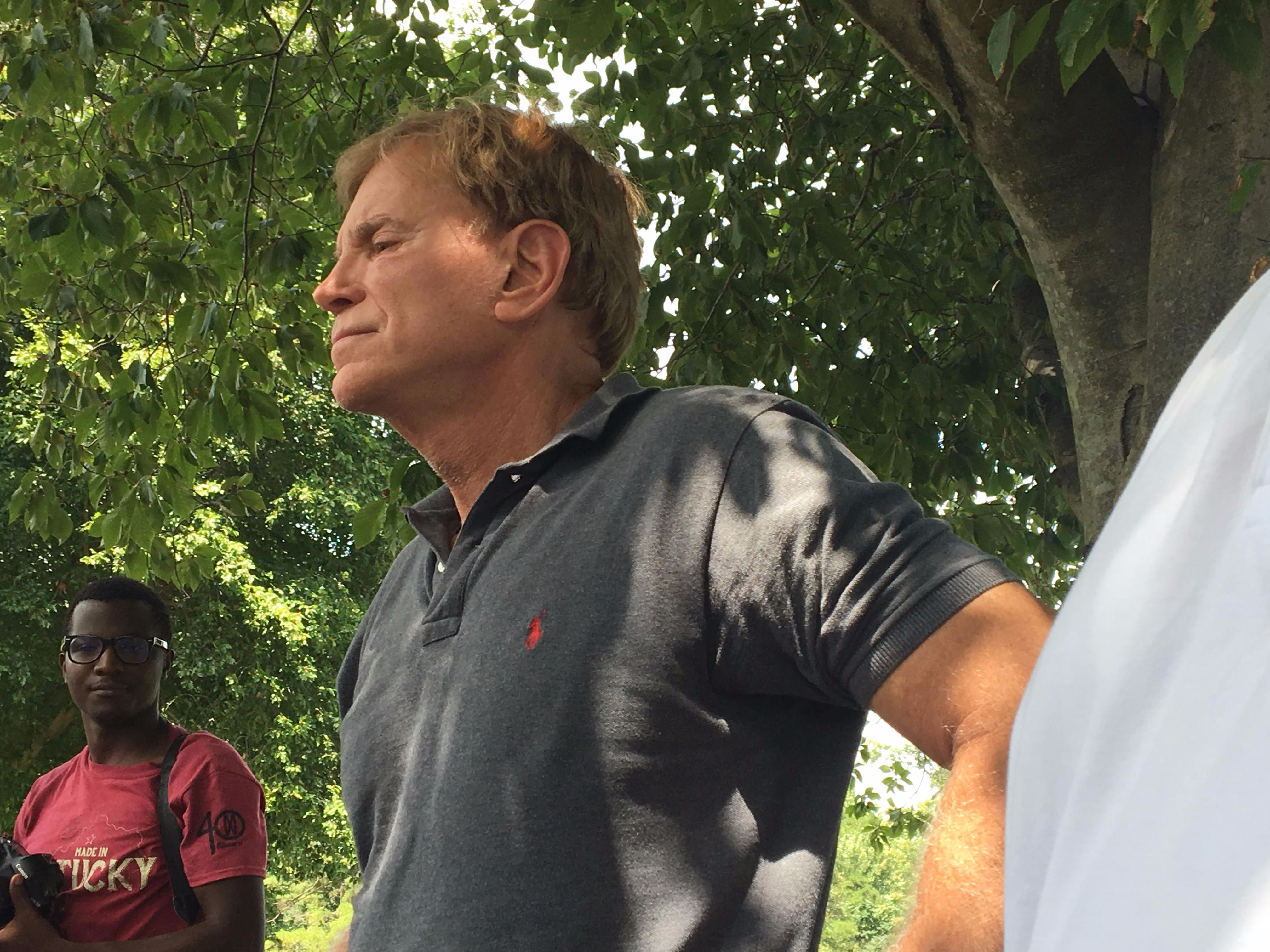
A founder of modern American neo-Nazism, David Duke [L, under the tree] told supporters in Charlottesville that they were “taking America back.”
A member of the group of supporters surrounding Spencer and the reporters volunteered an answer: “He is a Jew.”
“I actually don’t care. He could be Ethiopian,” Spencer added. “The way that he acted is absolutely outrageous. He looks like a fool and we’re going to make him look like an even bigger fool. That’s a lot of fun.”
When another reporter asked Spencer why he is using offensive language when speaking about a mayor who was democratically elected by residents of the city, Spencer responded: “Who cares? Hitler was elected. That’s what you guys always say.”
But then Spencer, a relatively young member of the American far right, was eclipsed by the arrival of an elder of the movement with even more name recognition and status.
“Duke, Duke, Duke,” the crowd chanted, as David Duke, the former KKK leader and poster boy of modern American neo-Nazism, walked straight into the supportive audience and stepped up to the bench-turned-podium.
“The courage you showed today in Charlottesville,” he told his supporters. “This is a first step toward making a realization of something that Trump alluded to early in the campaign — this is the first step toward taking America back.” And he explained: “European Americans face massive discrimination. Truth is that we’re being ethnically cleansed in our own nation.”
Later in the day, President Donald Trump criticized the events of the day and said such hate had no place in this country. He put the blames on “many sides” and ignored reporters who asked him why right-wing leaders like Duke feel inspired and supported by Trump.
A young couple of counter-protestors approached and began to heckle Duke. A small group of his supporters engaged in a profanity-laced shouting match with the couple, as Duke tried to complete his speech.
A minute later, organizers whispered in his ear that “something was going on” downtown. Duke apologized for cutting his remarks short and warned that more counter-protesters were on the way. It was time to leave, but not before one last shot of antisemitism.
Supporters broke out spontaneously with calls “The goyim know, the goyim know,” voicing a common neo-Nazi meme that implies a Jewish conspiracy behind attempts to shut down voices of the “goyim” — Yiddish for gentiles.
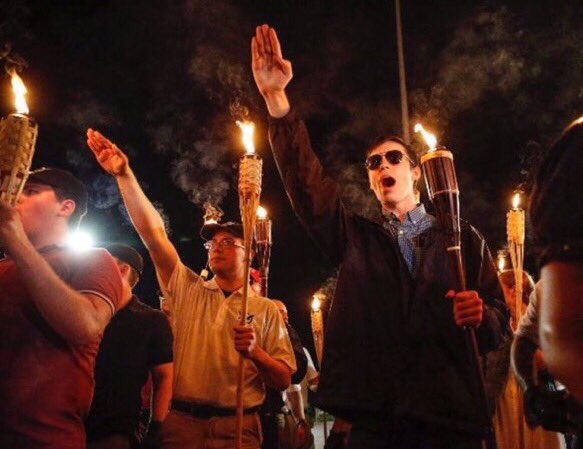
Opinion is divided by this tweeted (Tom Taylor) photo of white supremacists in Charlottesville – really scary or plain ridiculous?
The small group dispersed quickly as phones began to light up with the news alerts of the alt-right car attack against counter-protestors. The couple heckling Duke lingered on for another round of back and forth insults with the white nationalists as they made their ways to their cars, some carrying Confederate flags, others sporting bandaged fresh wounds from the day of battle.
They refused to talk or to answer any more of my questions, even though I made sure my hand covered the old sticker in Hebrew on the back of my recorder.
Contact Nathan Guttman at guttman@forward.com or on Twitter @nathanguttman
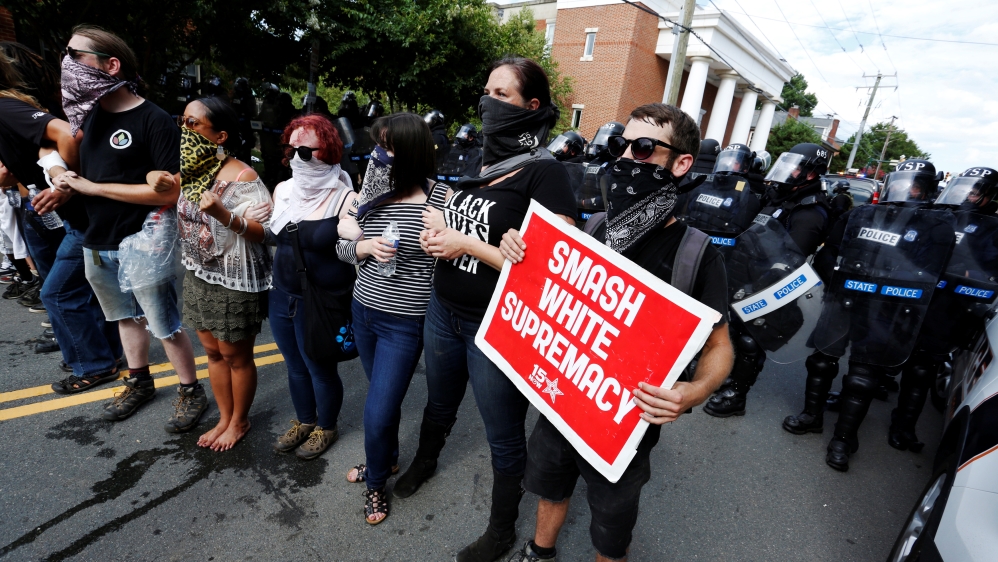
Far-right rallies in Charlottesville have met resistance from locals and anti-racists. Photo by Jonathan Ernst/Reuters
Why would Charlottesville racists do so much to protect a Robert E. Lee statue?
Documents show Lee was a cruel figure with the slaves he owned, encouraging overseers to severely beat them after escape attempts.
By Jamil Smith, LA Times
August 14, 2017
This is all over a statue, say the white supremacists who gathered in Charlottesville, Va., over the weekend. They claim that they sought to preserve an oxidized likeness of the traitor Robert E. Lee, still sitting 26 feet tall atop a stone pedestal in a local park that was once named after him. The Confederate general has been there, on his horse with hat in hand, since 1924. He remains there, despite a close City Council vote in April to sell and remove the statue and rechristen Lee Park as Emancipation Park. A circuit court judge gave it a reprieve, issuing an injunction that prohibits any sale or removal for six months.
The supremacists insist that preserving this statue was their goal when they marched in this small town — armed on Friday night with tiki torches, and on Saturday morning with bats, guns and a Dodge Challenger whose driver ran down counter-protester Heather Heyer, killing her and injuring 19 others.
What happened in Charlottesville was terrorism, that is certain. It is tempting, amidst the chaos the chanting Nazis provoked, to write off the statue as a MacGuffin, a plot device that isn’t clearly defined and is merely used to propel the story forward. Yet it merits attention in the aftermath. Like the white nationalists in Charlottesville, Confederate memorials terrorize people of colour and others, such as Heyer, who threaten the work of white supremacy.
/cdn.vox-cdn.com/uploads/chorus_asset/file/9038813/2.jpg)
Several hundred white nationalists and white supremacists carrying tiki torches marched through the University of Virginia campus on August 11, 2017, before clashing with a small group of counter-protesters. Photo by Evelyn Hockstein/The Washington Post via Getty Images
This wasn’t the first time these folks came to Charlottesville looking for trouble. The neo-Nazi Richard Spencer staged the first of several Klan-style demonstrations in Charlottesville on May 13, lighting torches weeks after the council vote. Less than two weeks later, Charlottesville Mayor Michael Signer wrote an op-ed for the Washington Post arguing that the Lee statue should remain. As a member of the City Council, he’d voted to keep it “as a reminder that many Americans were once treated as the property of others, then as second-class citizens.” He wanted a living history. What he failed to recognize was that many are still living that history. On many sides, as our president might say — as victims and as perpetrators.
White nationalism is not just a cultural legacy. It is an ongoing public safety crisis, and should be treated as such.
The statue of Robert E. Lee stands in the centre of Emancipation Park the day after the Aug. 12 Unite the Right rally in Charlottesville, Va. Photo by Chip Somodevilla / Getty Images
New Orleans Mayor Mitch Landrieu grasped what Signer did not. The same week that Spencer and his mob first descended on Charlottesville, Landrieu delivered a landmark speech outlining exactly why he pushed, successfully, to have his city’s monuments to the Confederacy and Jim Crow torn down.
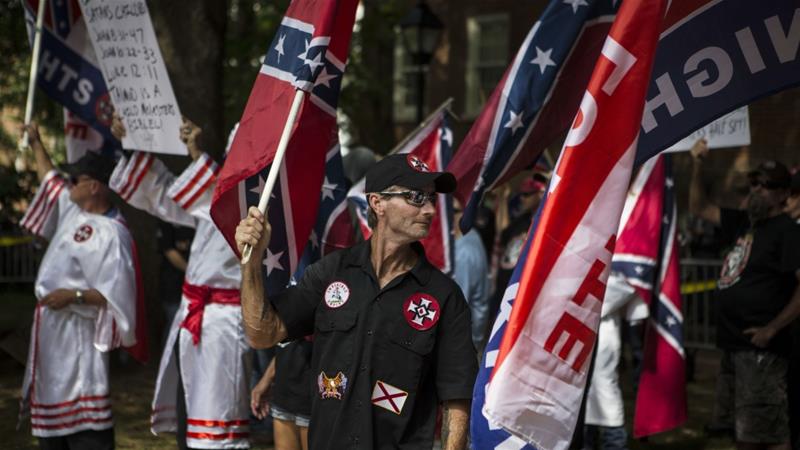
Why do right-wing men in particular like to dress up in regalia and go around at night with torches cultivating an atmosphere of secrecy? Photo of a white supremacist rally in Charlottesville a month ago by Chet Strange/Getty Images/AFP
“These monuments purposefully celebrate a fictional, sanitized Confederacy,” he said. “After the Civil War, these statues were a part of that terrorism as much as a burning cross on someone’s lawn; they were erected purposefully to send a strong message to all who walked in their shadows about who was still in charge in this city.”
In this way only does it start to make sense that racists would commit terrorism to defend monuments. The monuments themselves are terrorism. Thus the Lee sculpture honours a dishonourable man while encouraging his ideological descendants and expressing to black people that America is not ours, too. “White nationalist” is the appropriate term to use, since a white ethno-state is what Confederates sought and what their modern-day brethren still wish to achieve.
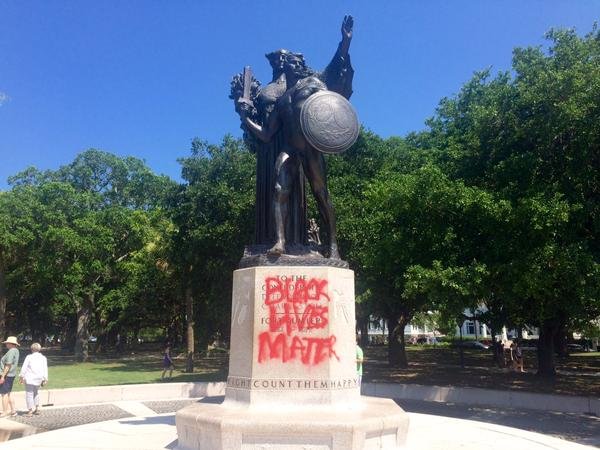
BLM graffiti has been spray-painted across many monuments to Confederate soldiers, this one in Charleston. Photo by Philip Weiss, Twitter.
After Charlottesville, it should be clear now to everyone that the urgency to rid ourselves of these markers of America’s racist past comes not from some childish desire to block out painful history, but to challenge a racist present. White nationalism is not just a cultural legacy. It is an ongoing public safety crisis, and should be treated as such.
Our president, of course, will not do so. In addition to advancing the goals of white supremacy through his administration’s regressive public policy, Donald Trump treats domestic terrorism with a blithe indifference. He proposed refocusing an anti-terrorism task force to focus solely on Islamists, and his Department of Homeland Security halted a $400,000 grant for Life After Hate, a group dedicated to de-radicalizing neo-Nazis.

A “Peace and Sanity” rally on Sunday Aug. 13, 2017, in New York, as speakers in Charlottesville, Va. address white supremacy violence. Similar anti-racist rallies were held in many American cities. Photo by Bebeto Matthews/AP
On Saturday afternoon, Trump dropped a “many sides” addendum at the end of his soft condemnation of the Charlottesville violence, blaming everyone and no one for what happened. Indeed, his remarks were so vague that Spencer and others were able to easily read into it what they pleased. The Daily Stormer, a neo-Nazi website, wrote that the “Trump comments were good. He didn’t attack us.” On Monday, Trump finally got around to stating that “racism is evil,” including “the KKK, neo-Nazis and white supremacists,” but only as part of a speech in which he — first — noted that the economy was strong.
Trump’s insufficient response is vital to understanding what the racist demonstrators intended to protect in Charlottesville. They didn’t want to simply guard the bronzed form of Robert E. Lee, a fellow white supremacist. They wanted to ensure that the work of white supremacy continues unabated. The statue is both a symbol of their lost cause and an excuse to commit violence. Now, these ethnic separatists have an ally in the White House. With his rhetorical flaccidity, the president of the United States made it clear that he wouldn’t renounce them. A general doesn’t leave his troops.
Jamil Smith is a writer in Los Angeles.
